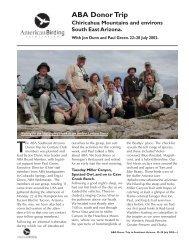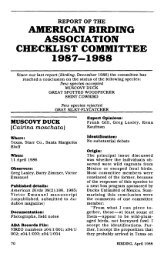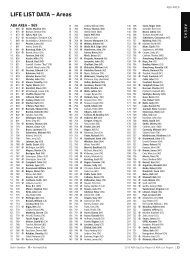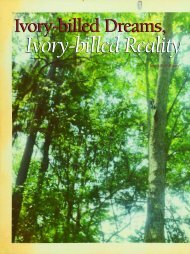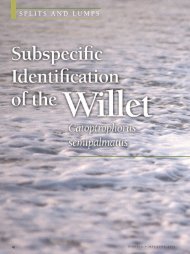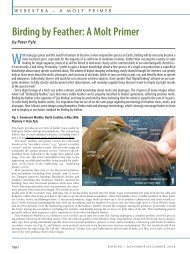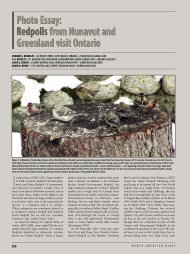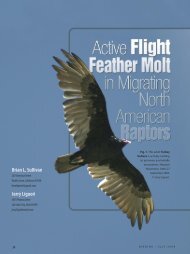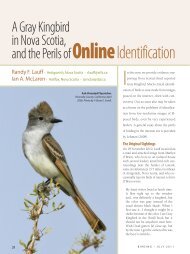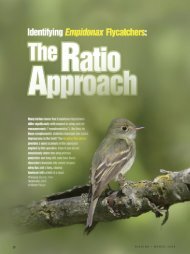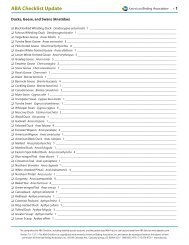2011 ABA Big Day & List Report - ABA Listing Central - American ...
2011 ABA Big Day & List Report - ABA Listing Central - American ...
2011 ABA Big Day & List Report - ABA Listing Central - American ...
- No tags were found...
You also want an ePaper? Increase the reach of your titles
YUMPU automatically turns print PDFs into web optimized ePapers that Google loves.
and invariably some silly misses will accrue. I once felt that 150 would be possible if everythingworked out. I guess I still believe that, but am still waiting to even crest 140. At notime did I feel like we were really wasting time that could have amounted to a betterspecies list. I have trouble imagining a better run than this past one, though a day or twoof advance scouting would improve the results undoubtedly. This year we did no scoutingother than participating in the Ocean City and Chincoteague CBCs - it would have beenvaluable to scout the Wal-Mart field (confusion over the directions cost us time) as wellas Assateague and Ocean Pines Pond (which we may have been able to cut had wescouted them previously - the extra time at Deal or the Inlet would have been valuable).MARYLAND #2 – 31 March 2000 – 0200 to 2200 – Species totals: 136/134.(Team/shared). Marshall J. Iliff (135), Mark L. Hoffman (135), James L. Stasz (134). Milesby Car: 260. Miles by Foot: 1. Visiting: Nassawango Creek, E.A. Vaughn W.M.A., BladesRd., Stockton, Ocean City, Nassawango Creek, Truitt’s Landing Rd., Assateague. Speciesof Note: Cattle Egret (M), Northern Pintail (M), Harlequin Duck (M), Northern Bobwhite(M), Sora (E), dowitcher sp. (R), Willet (E), <strong>American</strong> Woodcock (M), Northern Goshawk(R), Yellow-bellied Sapsucker (M), House Wren (M), Ruby-crowned Kinglet (M), Gray Catbird(M), Cedar Waxwing (M), Louisiana Waterthrush (E), Le Conte’s Sparrow (V).Comments: Continuing the thread of month-specific Maryland big day attempts, theintrepid team of Marshall Iliff, Mark Hoffman and Jim Stasz attempted a March Marylandbig day on 31 March 2000. We the 31 March 1999 effort by Iliff et al. as our standard(which recorded 136 species). The recent Iliff et al. January big day, which netted 138species (130 in Worcester County, see post of 1/12/00), also weighed heavily in our strategizing.Unlike last year, however, we decided (at Marshall’s suggestion!) to limit our effort toWorcester County (he’s getting smarter with age). In the January effort, the only non-Worcester time was at Deal Island at dusk (other than pre-dawn night birding), so we didnot think we would be sacrificing much. We felt it would be possible to make a legitimatestate-level attempt, in the single county. It would also allow more time birding, ratherthan driving. The prior March effort had started at Irish Grove and included Cambridge andElliott Island at the end, netting only 108 species in Worcester.I had birded in the county on 3/22, but otherwise we had no ‘hot’ bird-location information.A little bit of scouting the previous day did help out in some cases though. Alsoof value was a print-out from Hoffman’s database of Worcester County bird observations.Of some 72,000 records, he queried the file for all records falling between 20 March and5 April. The query gave some 3,000 records that were listed in taxonomic order. This helpedtarget priority species, potential locations and formalize the game plan. Iliff quickly committedthe print-out to memory.Jim Stasz joined us about 8:00 p.m. at our hotel in Pocomoke City and we finalized ourbase strategy for the day. We would use the January effort as a model, starting at theVaughn WMA central area (off of Rt. 12 just south of Girdletree), then hit Blades Road forany remaining woodland species we needed, then work back to the coast and north to OC.We would end with a sea watch, or if needed, at Truitt’s. We were asleep by 10:00 p.m.,attempting to violate Marshall’s little-sleep-before-a-big-day rule. The alarm came earlyat 2:00 a.m. nonetheless. After a coffee stop (Jim and I out-voted Marshall 2-1), we wereoff. The Hoffman-Stasz veto-proof majority would come in handy during several other criticalmoments during the day.We headed north on Rt. 13 out of Pocomoke City. We were going to head up to the Colbournearea along the northern part of Nassawango Creek, but I missed Rt. 113, so we enteredGod’s Country via Dividing Creek Road and Somerset County. You would not believethe grief received by ‘Mr. Worcester County’ every time he had to look at a map! Hey, thiswas a new route for me as well.We decided to night-bird the area north of the Pocomoke River and west of Rte. 12(Pocomoke State Forest/North) instead. Our first stop was along Nassawango Road justnorth of the country club at 2:42 a.m. It was bitterly cold, although with my long-johns andflannel-lined pants and gloves, not unbearable. I think Marshall and Jim were dressed fora May (or June?) run. Any Eastern Whip-poor-will with any sense would still be in Florida,and certainly none was willing to announce its presence. We made five stops, most in reliablewhip spots, but netted only Eastern Screech-Owl and Barred Owl. We left the forestat 3:18 a.m.We arrived at Truitt’s Landing at 3:41 a.m. In response to the King Rail tape at first allwas quiet, but then suddenly a roar of Rallidae brightened our spirits. Three species - King,Virginia and an early Sora. We tried hard for blacks, as they have been recorded here inwinter, but dipped. Great Horned Owls were calling to round out the easy owls. We leftTruitt’s at 4:30 a.m. and a quick stop at Cherrix Rd. at Boxiron Creek was quiet. We thenwent to the end of Taylor’s Landing Road to listen for Barn Owls. They have nested in theVaughn WMA area just to the south, and I have heard fly-overs in this general area severaltimes. Late-March is also prime time for migrating (and calling) Barn Owls. A ClapperRail called once for the marsh just to the south, unique for the day, which Marshall missedas he was screened by the car, but the no Barn Owls were heard. We left at 5:00 a.m. tostart the dawn chorus.Starting at 5:05 a.m. we birded the Vaughn central area. Just as we started out, a gobblingturkey north of the parking lot was a good one to get out of the way. The thicket area,that held thrasher, catbird, House Wren and Fox Sparrow during Christmas was relativelyunproductive, as we only scored the thrasher. We quickly headed for the marsh. The usualMarsh and Sedge Wrens cooperated, but the sharp-tailed sparrows were frustrating. Finallywe were able to claim 1 Nelson’s and 3 sharp-tailed sparrow sp. I spotted a Royal Tern fishingout over the bay that would prove to be unique, but a hoped-for bittern (of eitherspecies) failed to materialize.We headed back, working the field edges and thickets. Yellow-throated Warbler andgnatcatcher cooperated, and a single Fox Sparrow spotted by Marshall along the fieldedge would prove to be unique for the day. Winter Wren (our only as well) also called, butwe missed a number of passerines that would continue to haunt us throughout the day(sapsucker, waxwing, Ruby-crowned Kinglet, catbird, House Wren).We worked the area favored by the Harris’s Sparrow in late-December/January but if stillpresent, it was not cooperating. The Le Conte’s Sparrow area was totally flooded out, andwe were headed back to the car when Marshall spotted an accipiter which landed on theedge of a woods in clear view, an immature bird. Despite the clear shot, we were somewhatperplexed. Jim said something about the bold and broad white supercilium, while itsshort tail just seemed out of place. At better angle showed broad dark chevrons on thewhite undertail coverts. A Northern Goshawk! Simply amazing. County bird for both Marshalland Jim and only my second. Only 3 or 4 prior county records. Despite some misses,we were pumped by the gos, and left Vaughn at 8:14 a.m.We arrived at Blades Road (a great area for swamp-forest species along the Pocomoke)at 8:28 a.m. It was very quiet, but we did add White-breasted Nuthatch, Louisiana Waterthrushand Red-shouldered Hawk. This spot has produced Black-and-white Warbler forme on both April 2 (1994) and 5 (1998), but we could produce none today. Other possibilities,like Purple Finch or Rusty Blackbird, for which this area is very good in late March,failed to materialize as well. We left at 9:08 a.m.We then headed for the former Stockton Chicken Plant arriving at 9:20 a.m., whereHouse Wren, catbird and Purple Finch were seen on the CBC. The gate was locked, however,and our frustration showed. We need to find some passerine flocks and find themquickly. We worked George Island Landing Road (adding our only Black Vultures of theday), the boat ramp (adding Great and Snowy Egrets, and Boat-tailed Grackle). Given themany need landbirds, we changed our original plan at this point. Instead of starting thetrek north, we would work frequently productive landbirds spots along the southernboarder of the county. We made a circuit of Greenbackville, Swan Gut, <strong>Big</strong> Mill Pond andSteel Neck Roads, but the only passerine we could net were Barn Swallow and BrownCreeper. Jim spotted the latter from the back seat of the car. The car was parked at thetime! On the waterbird side, <strong>Big</strong> Mill Pond produced Pied-billed Grebe and Stockton Marshhad a Glossy Ibis. We wrapped up this leg at 10:48 a.m.We arrived at the Vaughn/North area (the large ponds off of Taylor’s Landing Road) at11:00 a.m. We got our first big slug of puddle ducks (Gadwall, Blue-winged Teal) andwere buoyed by seeing the previously located Le Conte’s Sparrow, leaving at 11:23 a.m.We worked north to Figg’s Landing, which had been so productive on 3/22, but it was dryand the shorebirds gone. Public Landing added Common Loon but no goldeneye or scaup.Public Landing Pond, where I have had luck with Northern Pintail in late March, had tealonly, and we were doomed to miss the pintail.Even greater disappointment set in when we checked the flooded fields that had beenso productive the day before. No shorebirds. Since it was low tide on the bayside, theworking hypothesis (per Iliff) was that the birds were out feeding in the marsh ponds.Hoffman favored the ‘a Merlin was here recently’ scenario. Another turkey in an open fieldoff Rt. 12 was a very temporary amusement. We left at 12:04 p.m. After quick gas andlunch stop in Snow Hill, we left at 12:19 p.m., refueled for the run to Ocean City.At the Worcester County <strong>Central</strong> Landfill, Marshall got us our Lesser Black-backed Gull,but we didn’t have time to try for anything better, leaving at 12:57 p.m. Quick stops at oldsapsucker, House Wren and Orange-crowned Warbler stake-outs in Newark proved fruitless.The Evans Road sparrow spot came through with the requisite White-crowned Sparrows,leaving at 1:27 p.m.Low tide at Ocean City was at 10:25 a.m., and we wanted to hit Eagle’s Nest as quicklyas possible. We bolted for there, with wheel-man Hoffman’s many hours of watching Formula1, NASCAR and CART races coming in handy throughout the day, although like in anendurance racer, performance waned as the hours passed. (He was practicing for the WorldSeries of Birding already). At Eagle’s Nest we added Dunlin, Black-bellied Plover, PipingPlover (7) and oystercatcher to our meager shorebird list, but could do no better.West Ocean City added Rock Pigeon (poor Jim was harassed for adding a bird to theday’s list), while the pond produced the usual suspects - Black-crowned Night Heron, Canvasback,Lesser Scaup, Ring-necked Duck, Ruddy Duck and a stake-out (from 3/22) imma-<strong>2011</strong> <strong>ABA</strong> <strong>Big</strong> <strong>Day</strong> <strong>Report</strong> & <strong>ABA</strong> <strong>List</strong> <strong>Report</strong> | 11



